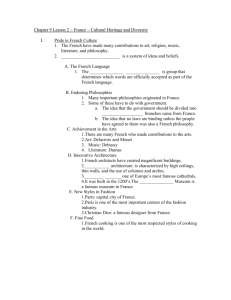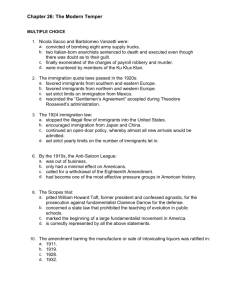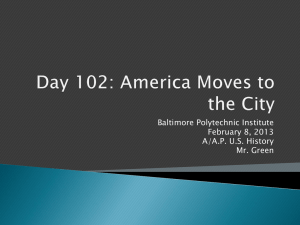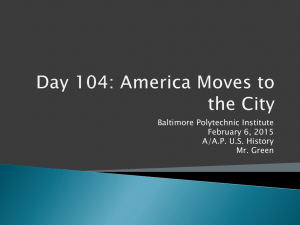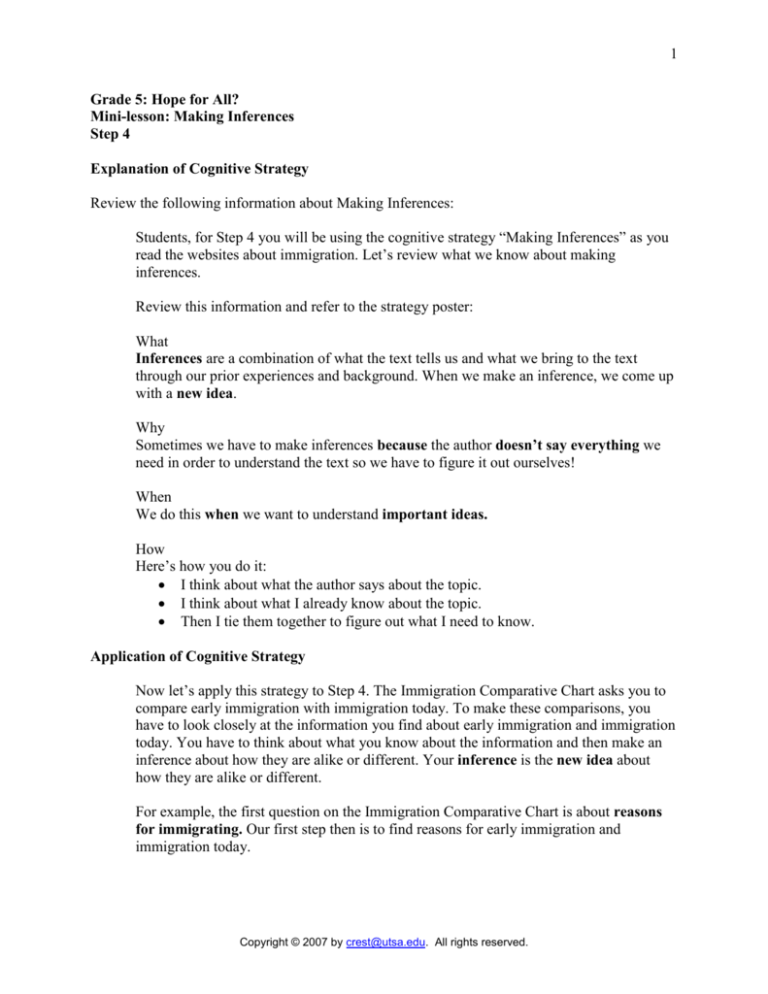
1
Grade 5: Hope for All?
Mini-lesson: Making Inferences
Step 4
Explanation of Cognitive Strategy
Review the following information about Making Inferences:
Students, for Step 4 you will be using the cognitive strategy “Making Inferences” as you
read the websites about immigration. Let’s review what we know about making
inferences.
Review this information and refer to the strategy poster:
What
Inferences are a combination of what the text tells us and what we bring to the text
through our prior experiences and background. When we make an inference, we come up
with a new idea.
Why
Sometimes we have to make inferences because the author doesn’t say everything we
need in order to understand the text so we have to figure it out ourselves!
When
We do this when we want to understand important ideas.
How
Here’s how you do it:
I think about what the author says about the topic.
I think about what I already know about the topic.
Then I tie them together to figure out what I need to know.
Application of Cognitive Strategy
Now let’s apply this strategy to Step 4. The Immigration Comparative Chart asks you to
compare early immigration with immigration today. To make these comparisons, you
have to look closely at the information you find about early immigration and immigration
today. You have to think about what you know about the information and then make an
inference about how they are alike or different. Your inference is the new idea about
how they are alike or different.
For example, the first question on the Immigration Comparative Chart is about reasons
for immigrating. Our first step then is to find reasons for early immigration and
immigration today.
Copyright © 2007 by crest@utsa.edu. All rights reserved.
2
The questionnaire in Step 1 asks this question, “What were some of the reasons early immigrants
came to work in the United States?” The questionnaire then directs us to look at this website:
http://content.scholastic.com/browse/article.jsp?id=5022
In the early decades of the 20th century the American people benefited from industrial growth
while also experiencing its adverse effects. Cheap labor and assembly-line manufacturing made
mass production possible. Railroad networks carried the mass-produced goods, many of them
the result of new technologies, around the country. Montgomery Ward, J.C. Penney, and other
retailers expanded their operations and laid the foundation for the consumer-driven society that
evolved later in the century. Materially, city dwellers' standards of living improved steadily, not
only in food, shelter, housing, and other material goods, but also in health care and education.
Inexpensive books, magazines, newspapers, and improved public libraries, funded in part
through the benevolence of Andrew Carnegie, contributed to their intellectual lives. Sexual
fulfillment in marital relationships continued to gain importance, and family life increasingly
reflected the ideals of companionship. Silent films and amateur and professional sports helped
fill leisure time. The Boy Scouts and Girl Scouts, founded in 1908 and 1910, provided
recreational and educational opportunities for children.
From this information, I can tell that during the early 20th century, America was experiencing
great industrial growth and needed people to work in factories, railroads, and stores. So one
reason for early immigration is that America needed workers and welcomed immigrants. Let’s
write that on the Immigration Comparative Chart.
Now what would make people from other countries want to come to America to work these jobs?
Let’s look at the questionnaire in Step 3. What information did we use to answer the first
question—what are some of the reasons early immigrants came to work in the United States?
Let’s go back to Link 1 from Step 3.
http://grants.coehd.utsa.edu/crest/WebQuest/CREST%20WebQuests/Grade%205/522/Documents/ShouldTheyStay.doc
America's first settlers were European immigrants who came to America to escape
religious discrimination. Other Europeans followed, seeking jobs and a better life. They
were not always welcomed with open arms, however. People often feared that
newcomers would take their jobs. Others disliked their cultural and religious values.
Also, look at this link from Step 1:
http://teacher.scholastic.com/researchtools/researchstarters/immigration/
http://content.scholastic.com/browse/article.jsp?id=5018
Immigration is a form of migration that signifies the intention of a person to settle permanently
in a new country. Motivating factors are generally economic, social, and political. Despite a
long history in the United States and some other countries of receiving immigrants, most people
Copyright © 2007 by crest@utsa.edu. All rights reserved.
3
who move from one country to another do not intend to leave their homelands permanently. In
recent decades, millions of refugees have been driven by civil war, natural disaster, and
persecution to seek safety outside of their countries. Millions of others leave for temporary work.
At one point in the 1970s, for example, about 10% of the labor force in both France and West
Germany was made up of foreigners. Ironically, while Italians sought and found work through
temporary-worker programs in central and northern Europe, northern Africans, Turks, and
others illegally migrated to Italy for the same reason.
To answer the question about early immigration, these sites tell us that people came to the U.S.
to escape religious persecution, to find jobs, and to have a better life. It also tells us that bad
things may have happened in their own country to make them leave, such as war or natural
disasters like floods and hurricanes. Let’s write these reasons down in the first column of the
chart.
For the next column we need to write reasons for immigration today. Let’s look at this website
again:
http://grants.coehd.utsa.edu/crest/WebQuest/CREST%20WebQuests/Grade%205/522/Documents/ShouldTheyStay.doc
Ashanty's message was one shared by many with her. She says that those immigrants
deserve to stay in the U.S. because they are here to work and give their families a
better life. Ashanty knows this in a very personal way. Her mom, an assistant manager
at a restaurant, came to the U.S. illegally from Mexico 18 years ago.
"[These people] are hard workers," the 14-year-old from Oregon told Scholastic News.
"All they are asking for is the chance to work and have the American Dream just like
everyone else."
America has always opened its doors to immigrants. It has also long discussed how to
welcome them, as well as how to regulate their numbers (see Immigration Nation).
How to handle illegal immigration has been a particular challenge. Now, Congress is
debating new immigration laws that could decide the fate of Ashanty's mother and
millions like her.
Most illegal immigrants come to America to escape poverty. More than half of the
people living in Mexico get by on less than two dollars a day. People can earn four or
five times that much in one hour in the U.S., as farm workers, in cleaning services, and
on construction jobs.
Let’s skim to see if this website can answer our question about why immigrants come to America
today. Notice what it says here. “They are here to work and give their families a better life.”
Then again it says “…the chance to work and have the American Dream.” In this paragraph it
says, “Most illegal immigrant come to America to escape poverty.” All three passages tell us that
immigrants come to America today for a better and to escape poverty. Let’s write that down.
Copyright © 2007 by crest@utsa.edu. All rights reserved.
4
For the last column we must look across our answers for why early immigrants came to America
and why they come today. We must decide what is similar and what is different. To do this, we
must take what we know, what we wrote down, and then think about this information to decide
what is similar and what is different. Many early immigrants came for religious persecution.
What do I know about that? I know that it means people, like the Puritans, could not worship the
way they wanted to so they came to America. What I just read about today’s immigrants does not
say anything about that, so, based on the website, I cannot say that they come today for religious
freedom. So I can infer that is one way they are different. In the first column we wrote that early
immigrants came for a better life in America and in the second column we wrote that the
immigrants come today to escape poverty. I think about what it means to escape poverty. That
means people want to earn more money in order to have a better place to live and more food to
eat. In other words, they want a better life for themselves. I can infer that this reason for a better
life is the same for both early immigrants and the immigrants today.
As you read the websites to answer the rest of the questions on the Immigration Comparative
Chart, keep asking yourself, “What do I know about this information?” and “How does what I
know help me to answer the questions?” Use the websites and what you know to infer your
answers for the last column about how the early immigrants and the immigrants today are alike
or different in terms of each category on the left of the comparative chart.
Copyright © 2007 by crest@utsa.edu. All rights reserved.




